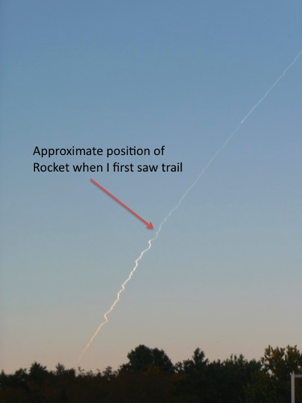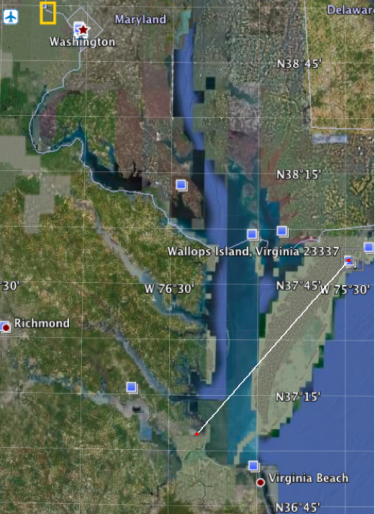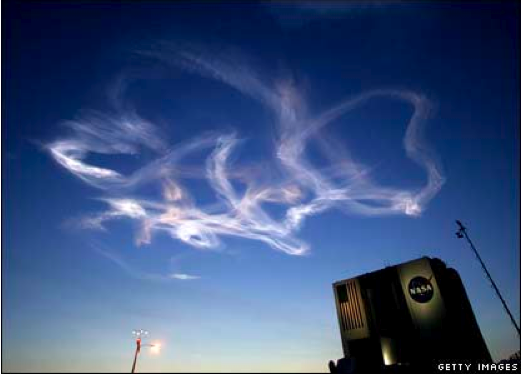by Dr. Lin Chambers
Recently I attended a band concert at my daughter’s middle school. As we were leaving the concert at about 8 pm, I glanced up at the sky and saw a curious sight. What an odd-looking contrail, I thought. A fellow parent, also a NASA employee, was better informed. That’s the trail from a rocket launch at NASA’s Wallops Flight Facility, he said. Of course, I thought, as soon as he said it. That explains the odd features of this “contrail”. A contrail, as readers of this blog know very well, is a condensation trail (a cloud) left in the sky after the passage of an aircraft (or, in this case, a spacecraft!).

Rocket launch as viewed from Hampton, VA. Photo courtesy Allen Kilgore, NASA Langley Research Center
There is a lot to be learned from looking at the sky, but it can be hard to read correctly because our perspective on Earth’s surface combines with the curvature of the Earth to produce some confusing optical effects. In this case, the perspective I had from a point about 115 km (~70 mi) southwest of the launch point (Fig. 2) made the trail appear at first like a regular contrail crossing the sky horizontally. But as I continued to watch, it became clear that this was no ordinary contrail. Rather than continuing across the sky, the trail clearly became higher and higher until it vanished entirely as the rocket left the bulk of the atmosphere behind.

Google Earth Map showing the location of the launch site (Wallops Island, VA), and my approximate location when I saw the trail, 115 km (~70 mi) to the southwest.
Aside from that high arc, this trail had some other odd features, even in the early part that looked at first glance like a horizontal contrail. Unlike a typical contrail, which is usually pretty smooth, this trail looked quite narrow and unusually wiggly, until at one point it smoothed out and became even and much fainter. Those wiggles in the early part of the contrail, I discovered, were from adjustments in the pointing of the rocket as it zoomed through the atmosphere. This is apparent in the video of the launch. (Click here to view)
The winds were relatively light that evening, so about 45 minutes later when we left a local ice cream shop after the post-concert celebration, the trail was still clearly visible overhead. However, having had time to drift some with the winds, the trail now looked like a contrail left behind by a crazed aerobatic pilot who was doing a series of loops. From my point of view, there was nothing to tell me that those loops weren’t a horizontal set of circles from a plane flying at a constant altitude. But, knowing that a rocket had left the trail, I could correctly interpret them as looking up a spiral of a trail laid out at higher and higher levels of the atmosphere.
I so wished that we had not just filled our camera’s digital memory card with the sights and sounds of a middle school concert band – no matter how good they were; and how proud we parents! Later I searched the web and found the picture below, from a Shuttle launch, which gives you some idea of what we saw.

The trail left behind after a Shuttle launch.
While this experience is an extreme example of perspective problems in the atmosphere, the same influences are at work whenever we humans look up at the sky. I encourage you to take opportunities to look up, and see if you can read the sky while correctly taking into account your ground-based perspective.

Hi
I have a very similar picture I have taken today over the UK.
If you would like to see it please give me an email address to send it via.
Hi Gill,
We would love to see pictures! Please share with us via our Facebook page at https://www.facebook.com/TheGLOBEProgram or send us an email at science@globe.gov. We’re looking forward to it!
Julie